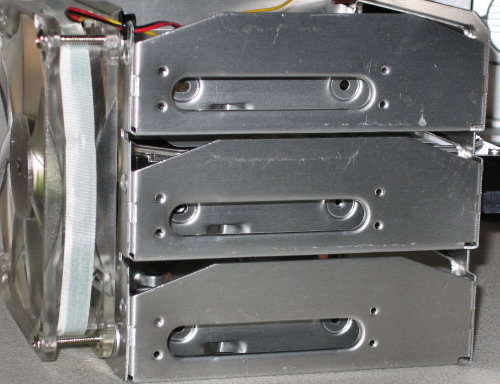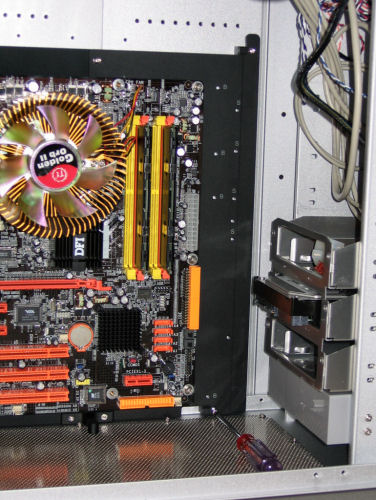Clash of the Titans - TT Tai Chi vs. CM Stacker 830
by Joshua Buss on February 23, 2006 12:05 AM EST- Posted in
- Cases/Cooling/PSUs
Thermaltake Tai Chi (cont’d)
The Tai Chi doesn't really do anything too out-of-the-ordinary when it comes to its components, and, in fact, is very similar to the hugely popular Armor and Kandalf cases released previously. For instance, the hard drive cage with attached 120mm blue LED fan is identical; however, this means that it inherits the not-so-appealing trait of requiring either a magnetic screwdriver or simply a little patience to secure drives in the cage with standard bolts.
Notice how the vents shown earlier are now obviously positioned smartly, directly above the PSU with a little space for extra heat to find its way out the holes. Another couple of nice features about this area are that even large supplies can be slid into place without removing the crossbar or anything else, and the supporting pieces on both sides are thick and sturdily attached.
Moving downwards, we find the Tai Chi's motherboard tray. This concept is simple, but the Tai Chi executes it slightly differently than previous incarnations, with it only being the plate itself instead of the plate plus back of the case. This is what allows the change from an ATX to a BTX style to be relatively simple – only the rear needs to change.
Besides being able to handle just about any motherboard form factor besides extended ATX, this black plate is thick and strong – the same 1/8” thickness as the rest of the metal in the case.
After putting the motherboard on the tray, putting it over the standoffs, and sliding it towards the back, two screws (one at the top and one at the bottom) are used to keep the tray from sliding forward.
With the ample space inside of the Tai Chi and the wide-opening door, putting this tray in place is quite simple, even after installing the hard drive cage. Another nice feature of the layout of the case is that if not all the drive bays are needed, a water cooling pump and even radiator can be placed on the bottom mesh/drive bay area. The options for setting up lots of additional components in the case are quite numerous.
The Tai Chi doesn't really do anything too out-of-the-ordinary when it comes to its components, and, in fact, is very similar to the hugely popular Armor and Kandalf cases released previously. For instance, the hard drive cage with attached 120mm blue LED fan is identical; however, this means that it inherits the not-so-appealing trait of requiring either a magnetic screwdriver or simply a little patience to secure drives in the cage with standard bolts.

Notice how the vents shown earlier are now obviously positioned smartly, directly above the PSU with a little space for extra heat to find its way out the holes. Another couple of nice features about this area are that even large supplies can be slid into place without removing the crossbar or anything else, and the supporting pieces on both sides are thick and sturdily attached.
Moving downwards, we find the Tai Chi's motherboard tray. This concept is simple, but the Tai Chi executes it slightly differently than previous incarnations, with it only being the plate itself instead of the plate plus back of the case. This is what allows the change from an ATX to a BTX style to be relatively simple – only the rear needs to change.
Besides being able to handle just about any motherboard form factor besides extended ATX, this black plate is thick and strong – the same 1/8” thickness as the rest of the metal in the case.

After putting the motherboard on the tray, putting it over the standoffs, and sliding it towards the back, two screws (one at the top and one at the bottom) are used to keep the tray from sliding forward.
With the ample space inside of the Tai Chi and the wide-opening door, putting this tray in place is quite simple, even after installing the hard drive cage. Another nice feature of the layout of the case is that if not all the drive bays are needed, a water cooling pump and even radiator can be placed on the bottom mesh/drive bay area. The options for setting up lots of additional components in the case are quite numerous.













55 Comments
View All Comments
Tamale - Friday, February 24, 2006 - link
I made the most prominent mention of it right before the sound chart:"With the finding that the Tai Chi cools just as well as the Stacker 830 with half as many fans, one has to wonder if that means that the Thermaltake fans are making substantially more noise. To see if that's the case, we used our sound pressure level (SPL) meter and rated the system's noise subjectively on a scale from 1 to 10."
Even without taking the fans into consideration, the two cases' temperatures were very, very close. Look at the HTPC roundup to see how much they've different in the past.
JoshuaBuss - Friday, February 24, 2006 - link
1) It's ok for different people to have different definitions of 'high-end'. For me, a great case for a decent price is higher-end than a case that costs twice as much and doesn't offer as much.2) I mention the passive radiative design of the Tai Chi as a benefit, but perhaps didn't stress enough that the design is for the most part a waste unless one attaches additional cooling equipment to the sides so that conduction of heat to the fins would actually take place. What is true is that the case cools exceptionally well with only two fans. Is it the fins helping? While certainly I agree with you that they're not helping that much, I would still say that they're helping a little.
3) The cage itself lacks any active defense against vibrations unfortunately. Its design is of thinner material that has more bends to it, so inherantely it will aborb a little bit of the vibrations, but not much. We really preferred CM's cage in this regard, for this and the 4 drive capacity. That being said, seagate barracuda drives are still very, very quiet in the Tai Chi.
fsardis - Friday, February 24, 2006 - link
making the case out of alu does help dissipate heat from inside. the hot air does make the alu hotter and the fins increase the contact area with the ambient air.the only proper argument against the heat sink design is that although it has fins to dissipate heat outside, it doesnt have a large contact area inside so the hot air of the interior wont transfer heat to the alu as fast. then again all this applies only in cases of passive cooling. with active cooling the whole heatsink design is wasted since the hot air gets thrown out and fresh air comes in.
i am the owner of a stacker 830 and i am disapointed to say the least. there is not a single spot in the case to mount even a single water cooling rad. having read so many reviews on the net about how this case is good for water cooling, i seriously question the validity of other reviewers and not of the anandtech reviewer.
ATWindsor - Friday, February 24, 2006 - link
I doubt the difrence between fins and no fins when the side only has contact with air is within uncertanties int he measurments, i see it as little more than a gimmick. And aluminum in itself also have little improvment in heat (over steel).LoneWolf15 - Thursday, February 23, 2006 - link
can be a pain already, but the dual-doors like on the Tai Chi are worse than a single one, IMO. It can make it really hard to put a case under a desk, or in a small area, and I would get really tired of having to open two doors every time I wanted access to one of my drives (which is why I got an Antec P-160, which stealths the optical/floppy drives quite nicely without needing doors).I like the CoolerMaster's design. Still not a fan of a door on a case, but it seems cleaner than Thermaltake, whose cases have always come off as somewhat gimmicky to me.
Good review, guys.
JoshuaBuss - Thursday, February 23, 2006 - link
The dual-doors aren't really as bad as you'd might think, but yes, it will definitely be a problem unless you have a large open space to the left of the tower... that is of course only if you care about opening it at all.. hehkalaap - Thursday, February 23, 2006 - link
I don't think this case is made for small spaces.latino666 - Thursday, February 23, 2006 - link
Uhh I can't see the pictures anyone know reason why?Also I did use Firefox and IE
ATWindsor - Thursday, February 23, 2006 - link
For some odd reason i don't get up pictures on anand anymore if i disable referer-logging, could that be the case for you?TallCoolOne - Thursday, February 23, 2006 - link
I also cannot see the pics, and also tried both Firefox and IE.